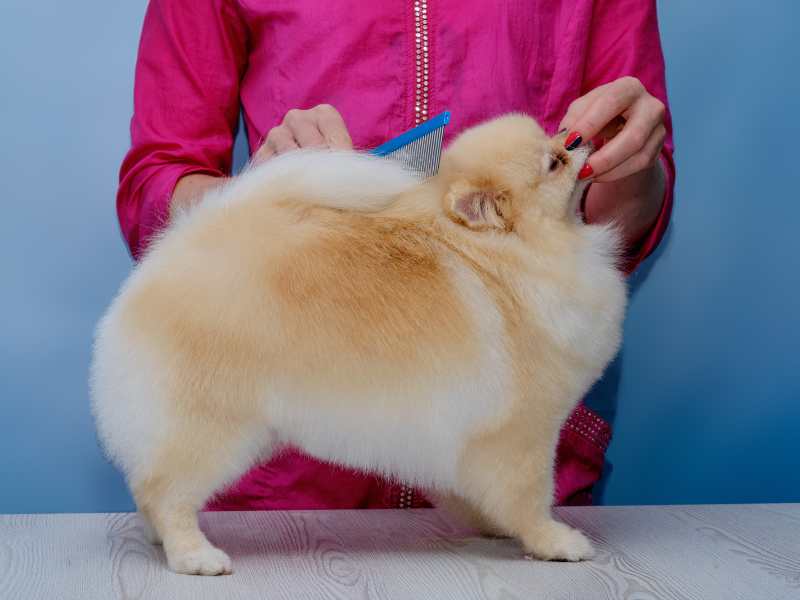
As experienced and loving Pomeranian owners, we empathize with the worry that arises upon discovering an unexpected growth on your petite pup.
That’s precisely why we’ve made this comprehensive guide outlining the diverse types of lumps, bumps, and cysts commonly found in Pomeranians, aiming to assist you in navigating the array of skin abnormalities that may arise throughout your dog’s life.
Based on our experience, we’ll offer insights on managing these conditions and provide indicators for when it’s time to seek advice from your veterinarian.
With the information we share in this article, you’ll be better prepared to decide whether your Pomeranian’s lump needs to be concerned or is simply a benign growth requiring minimal intervention.

Our Personal Experience as Pomeranian Owners
When we first found a small, hard cyst on our Pomeranian’s neck, fear and uncertainty consumed us.
Doubts flooded our thoughts: Was it merely another tick? Or could it potentially signify something more serious, such as a tumor?
Thankfully, a prompt visit to the veterinarian confirmed it as a benign sebaceous cyst, giving us a wave of relief.
However, the situation repeated itself. This time, in the dead of night, we discovered a sizable, alarming red swelling causing significant discomfort to our precious Pomeranian. Despite our frantic online search, we found nothing, leaving us engulfed in anxiety and uncertainty until we could reach the vet the next morning.
Now, as devoted guardians of multiple Pomeranians, we’ve acquired the wisdom to discern when to be alarmed and when to calmly monitor and administer care at home.
It motivated us to compile this comprehensive guide on lumps in Pomeranians, with the aim of aiding fellow Pomeranian owners in identifying, comprehending, and managing these potential health issues with greater confidence and ease.
13 Lumps, Bumps, and Cysts in Pomeranian
As a Pomeranian owner, it’s imperative to routinely inspect your dog for any peculiar lumps, bumps, or growths on their physique. These anomalies can vary from unharmed skin tags to more concerning issues such as tumors or infections.
Early identification and immediate veterinary assessment are vital for safeguarding your Pomeranian’s health and happiness, as certain lumps may need intervention or observation to prevent potential complications.
Below are several skin growths you might encounter in your Pomeranian throughout their lifetime…
1. Lipoma (Fatty Tumor)
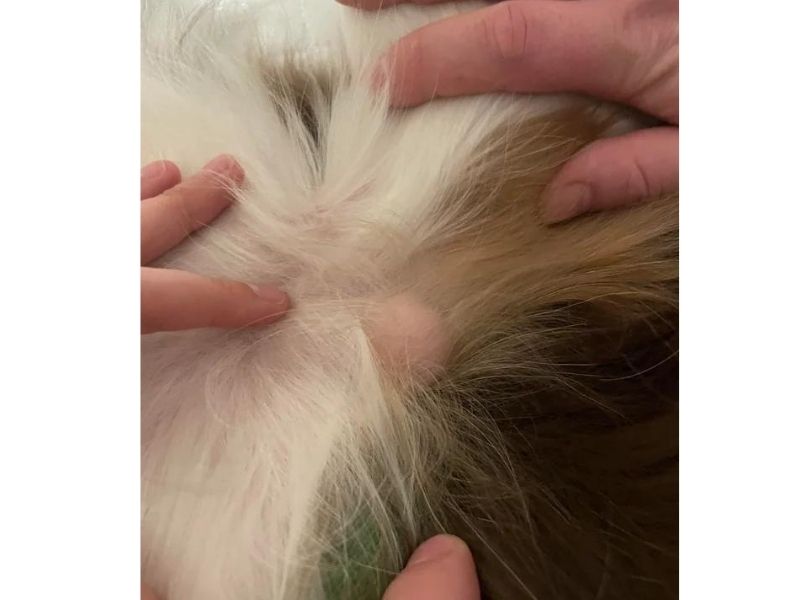
A lipoma, a benign (non-cancerous) fatty tumor forming beneath the skin, typically presents as a soft, rounded, and mobile lump. While lipomas can manifest in any canine breed, they are notably frequent in Pomeranians.
These growths usually emerge due to the overgrowth of fat cells and are more frequently observed in older or overweight Pomeranians. Despite the precise cause of lipomas remaining elusive, genetic predispositions and obesity are suspected to contribute to their development.
- Lipomas typically have a soft and rubbery texture.
- They are commonly in the shape of a round or oval.
- Sizes can range from as tiny as a pea to as big as a softball.
- While they are frequently found just beneath the skin, they can also be found deeper within the body.
- Lipomas have the potential to develop in any part of the body containing fatty tissue.
- It is commonly found in the neck, chest, abdomen, and limbs.
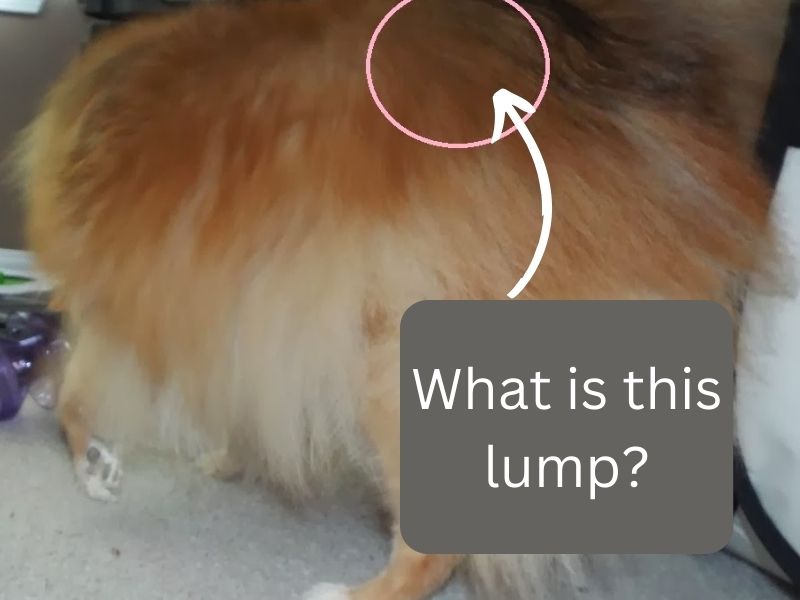
- Typically, lipomas are asymptomatic and do not elicit any noticeable signs.
- They typically lack pain and do not induce discomfort.
- However, larger lipomas might affect the movement, give pressure on the tissues around it, or stretch the skin, resulting in localized itching.
- In most cases, lipomas do not need any treatment.
- Should the lipoma be situated in a sensitive region or induce discomfort, surgical excision might be advised.
- Alternatively, aspiration, which entails extracting the fatty tissue using a needle, could be considered for small lipomas positioned just beneath the skin.
- Monitoring the lipoma’s progression may also be viable if it remains asymptomatic.
Based on our observations, the majority of our Pomeranians have developed lipomas. While surgical removal may be suggested by your veterinarian, thorough consideration is essential before making a decision.
This is primarily due to the probability of these fatty masses to grow across various regions of the body, potentially complicating the safe and complete removal of all present and future growths. It’s crucial to carefully assess the risks and advantages of surgical intervention under the guidance of your veterinarian.
2. Abscesses
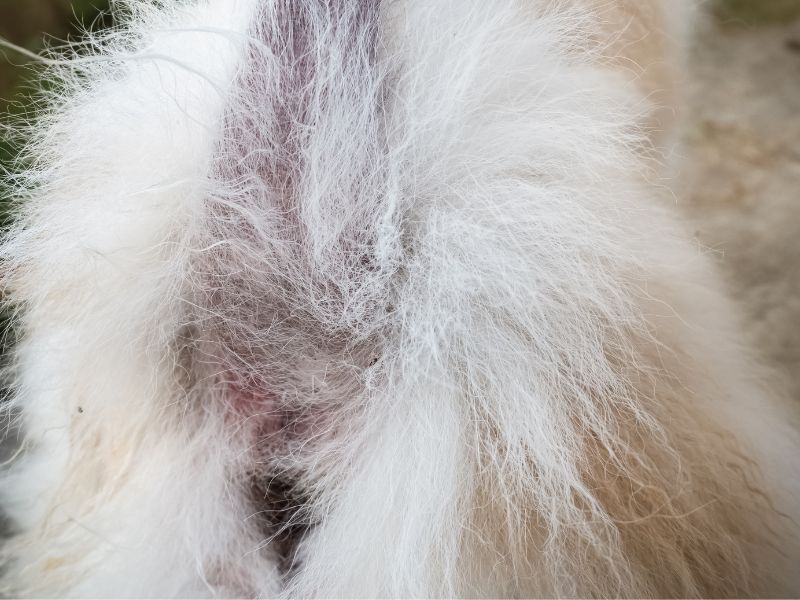
A Pomeranian may develop an abscess, a confined accumulation of pus triggered by a bacterial infection, which can manifest in various areas of the body, including the anal glands. Due to their anatomy and susceptibility to anal sac problems, Pomeranians are prone to experiencing anal gland abscesses.
These abscesses, including those affecting the anal glands, can emerge following skin trauma, insect bites, or underlying ailments that facilitate bacterial infections.
- Abscesses typically manifest as swollen, tender lumps or bumps on the skin, causing discomfort.
- They may contain pus or fluid and can exhibit warmth upon touch.
- The surrounding area might appear red, swollen, and sensitive.
- Abscesses have the potential to develop on any part of the body with skin.
- In Pomeranians, anal gland abscesses are prevalent in the anal region, representing a common form of this condition.
- The symptoms of abscesses in Pomeranians vary depending on the abscess’s location and severity.
- Signs may encompass swelling, discomfort, redness, and sensitivity in the impacted area.
- If the abscess ruptures, it may discharge pus.
- Additionally, your Pomeranian might exhibit fever, lethargy, or general malaise in certain instances.
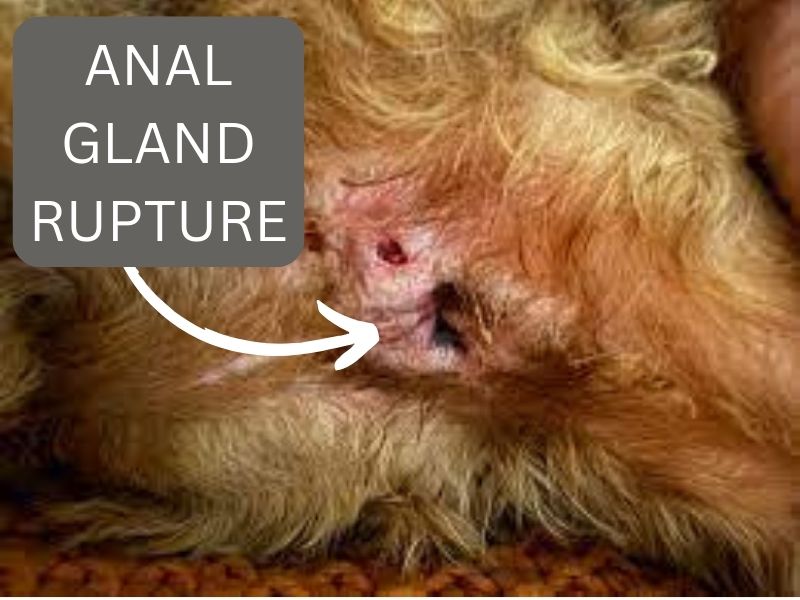
- Managing abscesses in Pomeranians generally entails draining the pus and addressing any underlying infection.
- Your veterinarian might prescribe antibiotics or other medications to combat the infection and facilitate recovery.
- In certain situations, surgical intervention may be required to excise the abscess and any adjacent infected tissue.
When you observe a red, swollen, or painful lump on your Pomeranian, it is imperative to immediately seek veterinary evaluation.
Timely examination is crucial as it can aid in swift treatment if the lump is determined to be an abscess, thus mitigating the risk of infection spread and fostering prompt healing.
3. Dental Epulis
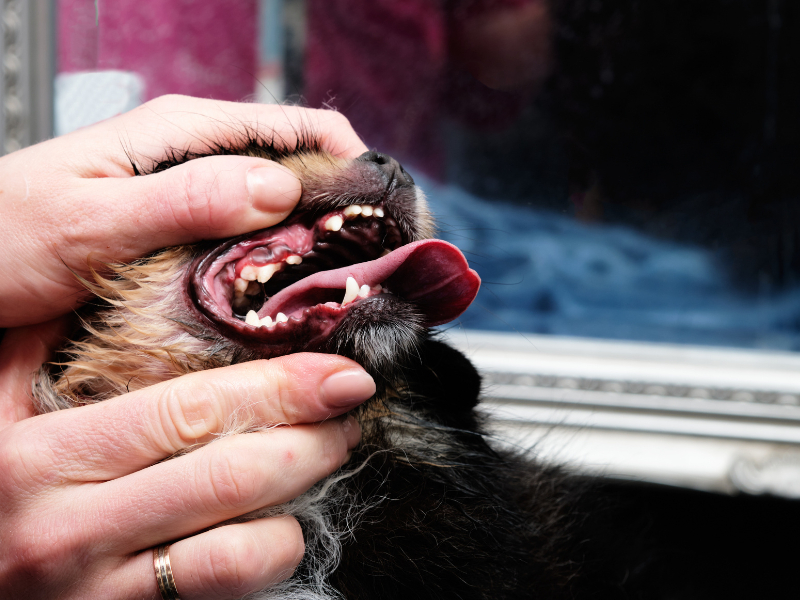
A dental epulis is a benign tumor that tends to grow slowly on a dog’s gums or oral soft tissue. Pomeranians, known for their enthusiastic chewing habits, are prone to acquiring more dental and oral injuries compared to other breeds, making them susceptible to this condition.
While generally not causing pain, epulis can hinder eating and chewing if they enlarge. Early identification and treatment are crucial for averting complications and preserving oral well-being.
- A raised lump or bump on the gums, typically located close to a tooth.
- The lump may be on a smooth or rough surface and may vary in size.
- Its consistency tends to be firm, contingent on the specific type of epulis.
- The mass may be connected to the gum tissue or the underlying bone.
- These growths typically manifest on the gums or other oral soft tissue.
- Epulis usually emerge towards the rear of the mouth, in proximity to the molars.
- In certain cases, epulis may extend to the palate or other regions within the oral cavity.
- Signs of discomfort or pain during eating or chewing.
- Bleeding or discharge from the growth or nearby gums.
- Development of halitosis, or bad breath, along with potential loosening of teeth.
- Reluctance to consume food or loss of appetite
Dental Epulis: Treatment Approaches
- Surgical removal is the primary treatment for epulis in which the growth and adjacent tissue are removed under general anesthesia.
- In certain cases, radiation therapy might be employed to reduce the size of the epulis. This approach is generally considered for cases where surgical removal isn’t feasible or for dogs who aren’t suitable candidates for surgery due to health concerns.
- Your veterinarian may prescribe medication to reduce pain, prevent infection, or manage any underlying periodontal issues.
- For small or gradually developing epulis that don’t affect eating or chewing, periodic observation may suffice. Routine dental assessments and follow-ups are essential to monitor the growth and prevent the condition from getting worse.
It’s important to acknowledge that not all dogs with epulis may display every symptom mentioned, and some may not exhibit any signs until the growth has advanced. If you observe any alterations in your dog’s mouth or behavior, it’s crucial to promptly arrange a veterinary appointment for a comprehensive assessment.
4. Interdigital Furunculosis (Cysts)
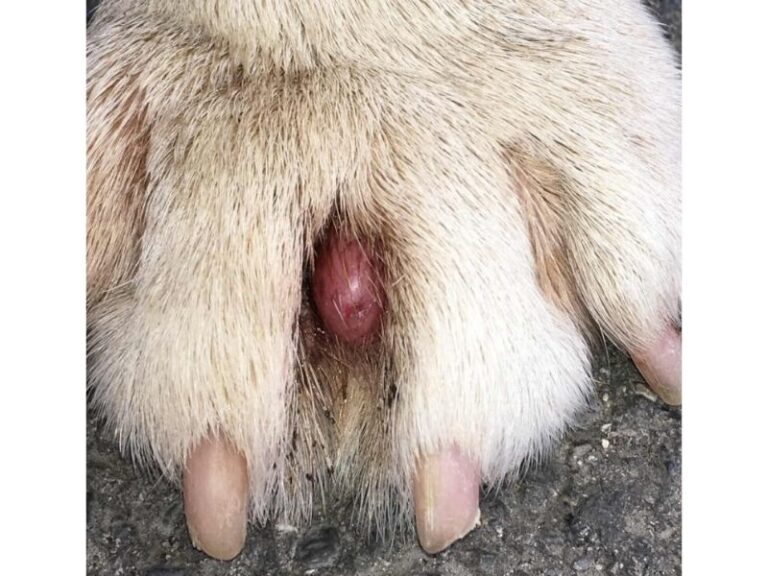
- Interdigital furunculosis presents as tender, swollen, and inflamed lesions nestled between a dog’s toes.
- These lesions can vary in size and intensity, spanning from small and isolated to extensive and widespread.
- Accompanying symptoms may include redness, swelling, and discharge from the affected area.
- Interdigital furunculosis manifests between the toes and is predominantly observed on the front paws.
- Signs of interdigital furunculosis in Pomeranians could manifest as limping or favoring one paw, excessive licking or biting at the infected area, and indications of pain or discomfort.
- These lesions may coincide with redness, swelling, and discharge,
- The affected region might emit a foul odor.
- Managing interdigital furunculosis in Pomeranians typically entails cleansing the affected area and administering a veterinarian-prescribed topical or systemic medication.
- Antibiotics may also be necessary to stop the infection and reduce inflammation.
- In severe cases, surgical intervention might be essential to excise the affected tissue.
- Identifying and addressing the root cause of interdigital furunculosis, such as allergies, autoimmune disorders, or other skin irritations, is imperative for effective treatment.
5. Sebaceous Cyst
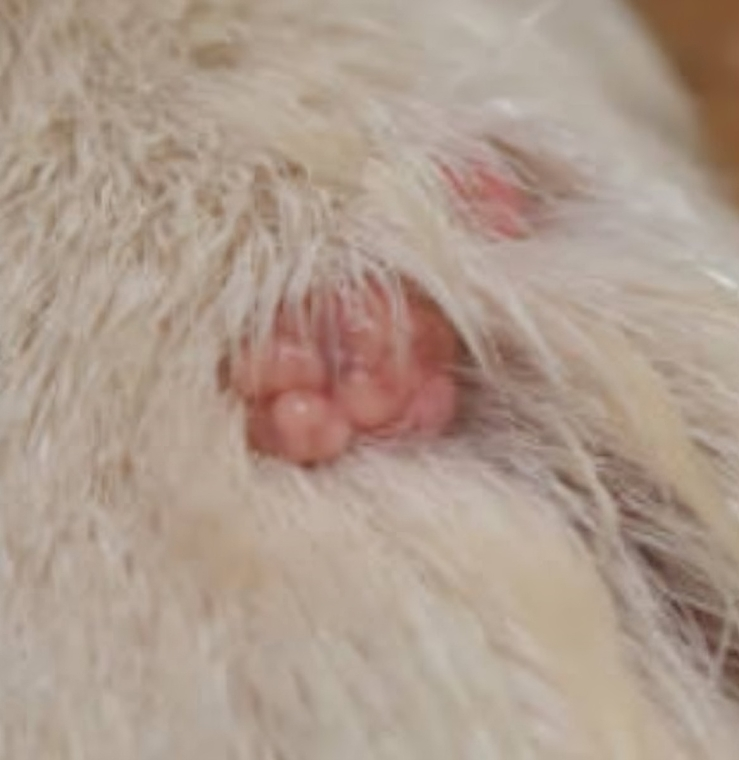
- In Pomeranians, sebaceous cysts commonly present as solid, circular masses located just beneath the skin’s surface.
- These cysts typically lack sensation and do not induce discomfort.
- Sizes can range from as small as a pea to as big as a golf ball.
- The cysts may contain a dense, yellow or white, pasty substance.
- Sebaceous cysts have the potential to develop in any region where hair follicles are present on the body.
- While they commonly appear on the neck, back, and head, they can also arise in other bodily areas.
- Sebaceous cysts typically remain asymptomatic in the majority of cases.
- They commonly lack pain and do not induce discomfort.
- However, larger cysts may impede movement or exert pressure on neighboring tissues.
- For the most part, sebaceous cysts in Pomeranians necessitate no intervention.
- However, if the cyst induces discomfort or is situated in a delicate region, surgical excision might be advised.
- The veterinarian will make an incision over the cyst and, if necessary, extract the cyst along with adjacent tissue.
- In certain cases, drainage of the cyst may precede its removal.
- In rare occurrences, infected sebaceous cysts may necessitate antibiotic treatment.
6. Skin Tags
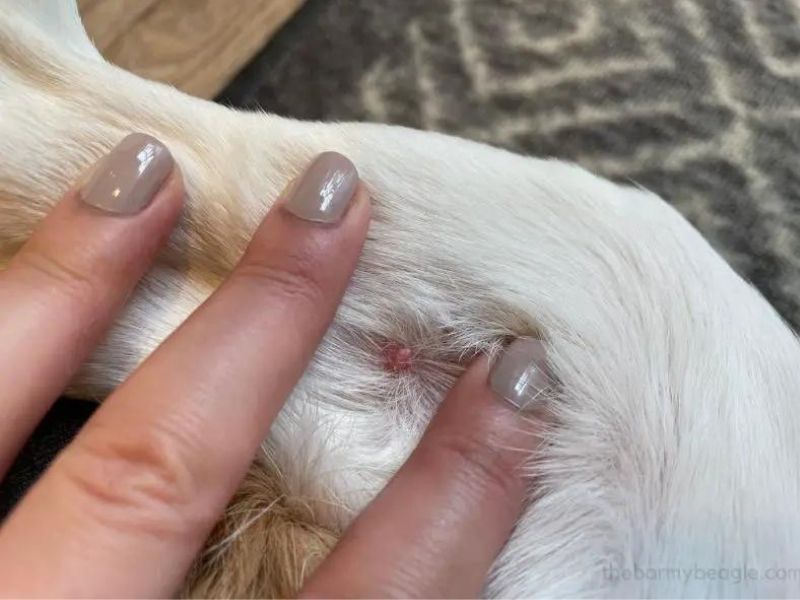
Skin tags, alternatively referred to as acrochordons or fibro papillomas, are tiny, noncancerous growths that extend from the skin’s surface and are prevalent among aging canines.
The precise cause of skin tags remains unclear, but they are thought to arise from friction, genetic predispositions, or hormonal influences, often presenting as pliable, stalk-like projections on the skin.
- Skin tags manifest as small, soft, flesh-colored, or brown growths on the skin’s surface.
- Often connected to the skin by a slender stalk or peduncle,
- they typically lack sensation and do not induce discomfort.
- Skin tags have the potential to emerge in any area where there is skin.
- They are frequently observed on the neck, chest, and beneath the legs.
- Skin tags generally remain asymptomatic.
- While they may be observable and evident to the owner, they typically do not induce discomfort in the Pomeranian.
- Treatment for skin tags in Pomeranians is often unnecessary, given their benign nature and lack of discomfort.
- However, if a skin tag triggers discomfort or irritation, especially when located in a sensitive area, surgical removal can be considered.
7. Folliculitis
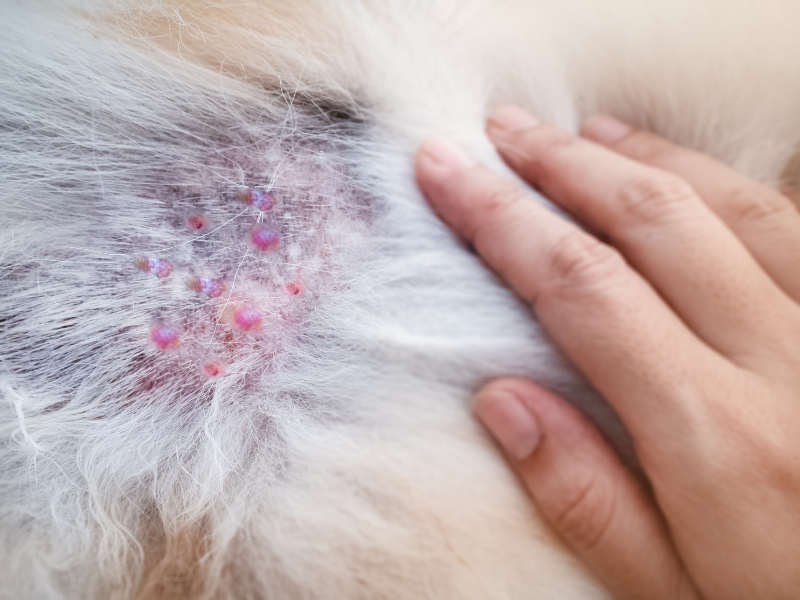
Folliculitis, characterized by inflammation or infection of hair follicles, leads to red, inflamed, or pus-filled bumps on the skin. Although it can affect any dog breed, it’s relatively common in Pomeranians, who are susceptible to skin issues.
Folliculitis may arise from multiple factors, including bacterial or fungal infections like yeast, allergies, or skin irritation, often occurring when the immune system is weakened or the skin’s natural defenses are compromised.
- Folliculitis manifests as small, red bumps on the skin’s surface.
- These bumps can vary in texture, appearing either raised or flat, and may induce mild itching or discomfort.
- In more severe cases, the bumps may contain pus or other fluid.
- Folliculitis bumps may emerge in areas where hair follicles are present across the body.
- Common locations for these bumps include the belly, legs, and around the mouth and nose.
- Apart from the appearance of skin bumps, signs of folliculitis in Pomeranians may involve mild itching or discomfort.
- The Pomeranian may exhibit scratching or licking behavior at the affected site, causing worse irritation.
- Typically, treating folliculitis in Pomeranians entails antibiotics and/or the use of medicated shampoos.
- Your veterinarian may suggest a skin biopsy to verify the diagnosis and eliminate other potential conditions.
- It’s crucial to adhere closely to your veterinarian’s treatment regimen and to keep a vigilant watch for any indications of deterioration or recurrence in your Pomeranian.
8. Hives
Hives, medically termed urticaria, manifest as raised, red, and itchy welts on the skin, resulting from an allergic reaction.
These welts usually emerge abruptly and can be elicited by a range of factors, including insect bites, medications, food, or environmental allergens, prompting the release of histamine and other inflammatory compounds in the skin.
- Hives present as elevated, red, or pink welts on your dog’s skin.
- These welts might induce itching or discomfort in your Pomeranian.
- Sizes can range from small and unnoticeable to large and easily felt under the skin.
- Hives have the potential to develop on any part of your Pomeranian’s body where there is skin.
- They may appear in a single area or extend across multiple areas of the body.
- Signs of hives in Pomeranians might encompass itching, redness, and swelling in the affected area.
- Your Pomeranian may exhibit scratching or licking behavior at the site, making the irritation worsen.
- In severe cases, hives can induce difficulty in breathing, necessitating urgent medical intervention.
- The approach to treating hives in Pomeranians depends on the intensity of the rash and its underlying cause.
- For mild cases, the rash may resolve spontaneously or with the aid of an over-the-counter antihistamine medication.
- In severe situations, your veterinarian might recommend a prescription-strength antihistamine or corticosteroid medication to alleviate symptoms.
- Identifying and steering clear of the trigger that induced the hives, whether it’s a food, medication, or environmental irritant, is essential to avert future flare-ups.
Pinpointing and addressing the diverse array of triggers for hives in Pomeranians is important to safeguarding your Pomeranian’s health and ensuring their comfort.
9. Papilloma (Warts)
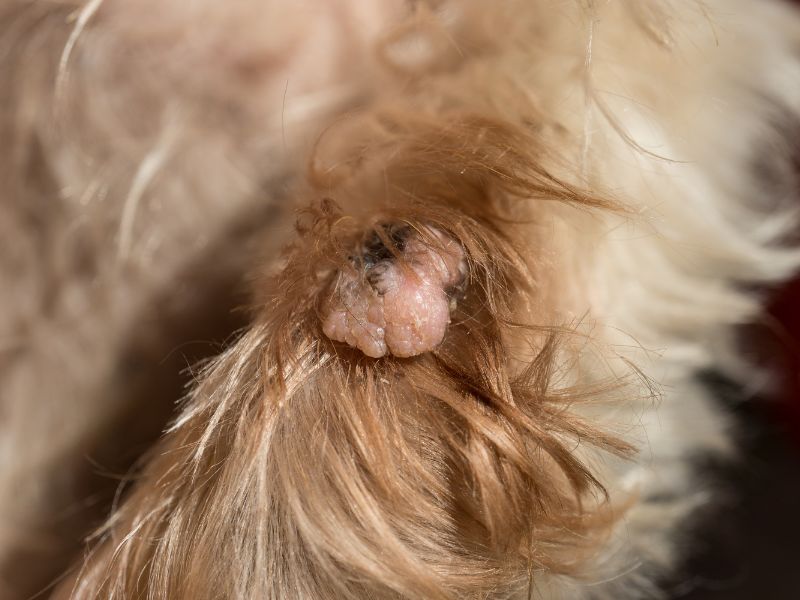
Papillomas, commonly referred to as warts, are small, noncancerous growths on the skin instigated by the papilloma virus.
These growths typically manifest as rugged, cauliflower-like protrusions and emerge when a Pomeranian’s immune system encounters the virus, often through direct interaction with infected dogs or contaminated surfaces.
- Papillomas manifest as petite, elevated nodules on the skin’s surface.
- They can exhibit either a smooth or rough texture and may display hues of pink, brown, or black.
- Typically, papillomas are causing any pain and do not induce discomfort in the Pomeranian.
- Papillomas have the potential to develop on any region of the body where skin is present.
- They are frequently observed on the face, lips, and in the area of the mouth.
- Alongside the appearance of papillomas on the skin, signs of papillomas in Pomeranians might encompass mild itching or discomfort.
- Your Pomeranian may engage in scratching or licking behaviors at the affected site, making the irritation worsen.
- Treating papillomas in Pomeranians might be unnecessary if they are not posing any issues.
- However, if the papillomas become infected or irritated, your veterinarian may suggest topical therapies or the removal of the papillomas.
- In certain cases, papillomas may spontaneously resolve without the need for intervention.
Is it possible for humans to contract warts from dogs?
Humans are not at risk of contracting the papillomavirus from dogs, as the virus is specific to each species. The papilloma virus affecting dogs differs from the one affecting humans, with each type adapted to infect a particular species and usually not transferring between different species.
While papillomas in Pomeranians are generally non-harmful and may not necessitate treatment, they can become infected or irritated if left untreated.
10. Perianal Adenoma

- Perianal adenomas manifest as petite, elevated lumps encircling the anus and rectum.
- They usually exhibit well-defined boundaries, signifying they possess a clear border or edge.
- Texture-wise, perianal adenomas may be either firm or soft and can vary in size from a few millimeters to several centimeters.
- Perianal adenomas are located within the perianal region, encompassing the vicinity surrounding the anus and rectum.
- Aside from the presence of masses in the perianal region, signs of perianal adenomas in Pomeranians might include discomfort or pain while defecating or urinating.
- The Pomeranians may engage in licking or biting behaviors at the affected site, making the irritation worsen.
- Managing perianal adenomas in Pomeranians may entail surgically excising the tumors.
- Additionally, neutering might be advised, particularly since perianal adenomas are more prevalent in unneutered males.
- In certain cases, medication may be prescribed to aid in shrinking the tumors.
11. Histiocytoma
A histiocytoma is a benign skin tumor that develops from immune cells known as histiocytes. While histiocytomas can arise in any breed of dog, they are particularly prevalent in younger canines, usually under the age of three.
These tumors typically manifest as small, circular, hairless growths on the skin that grow rapidly and frequently diminish on their own without requiring treatment over the course of several weeks to months.
- Histiocytomas manifest as small, circular, hairless masses on the skin,
- It is typically measuring less than 2 cm in diameter.
- Their hue commonly ranges from pink to red, and they exhibit a smooth, elevated surface.
- At times, they may resemble warts in appearance.
- Histiocytomas have the potential to develop on any part of the body covered by skin.
- They are frequently observed on the head, neck, and legs.
- Typically, histiocytomas do not exhibit any symptoms.
- They generally do not cause any pain and discomfort.
- They may experience rapid growth within a few weeks, followed by spontaneous disappearance over the next few months.
- In the majority of cases, histiocytomas resolve without the need for treatment and spontaneously disappear.
- However, if the histiocytoma induces discomfort or is in a sensitive region, surgical excision may be advised.
12. Mast Cell Tumor
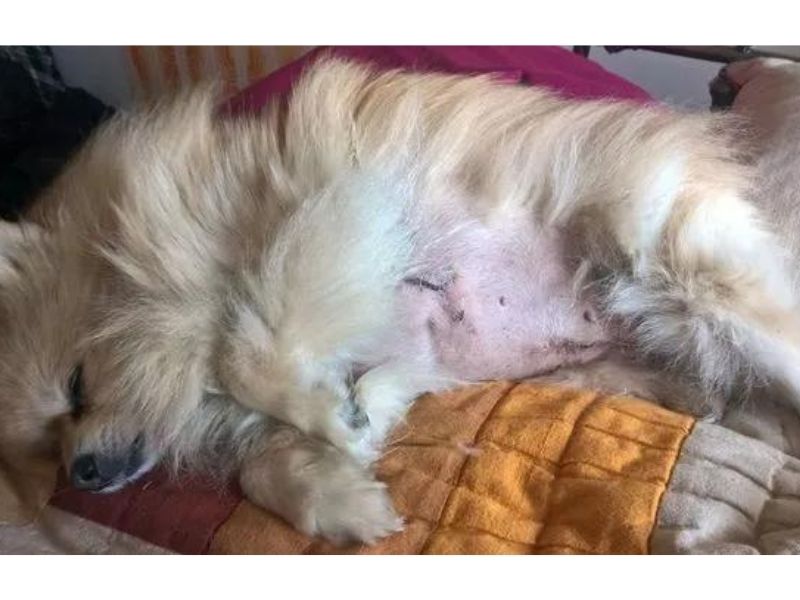
Mast cell tumors are cancers originating from mast cells, immune cells implicated in allergic responses and inflammation. Although these tumors can manifest in any canine breed, Pomeranians are predisposed to this malignancy.
The precise cause of mast cell tumors remains uncertain, although genetic predispositions, environmental factors, and immune system irregularities are believed to contribute.
These tumors often present as elevated, itchy, or ulcerated masses on the skin and necessitate immediate veterinary assessment for diagnosis and intervention.
- Mast cell tumors may manifest as elevated, red, or pink nodules on the skin,
- It is exhibiting a range of sizes from subtle to palpable masses.
- Additionally, these tumors can present with ulceration, characterized by disrupted skin over the tumor site, potentially resulting in bleeding or oozing.
- Mast cell tumors have the potential to develop in any area of the body covered by skin.
- However, they are frequently observed on the trunk, limbs, and head.
- The indications of mast cell tumors in Pomeranians hinge on the tumor’s size and location.
- While certain dogs may exhibit no symptoms, others may experience itching, redness, or swelling at the tumor site.
- Occasionally, the tumor may induce pain or hinder movement.
- The treatment options available for mast cell tumors in Pomeranians depend upon various factors such as tumor size, location, and cancer stage.
- For localized tumors, surgical removal is frequently recommended and can be curative if the tumor is excised before spreading to other body parts.
- In some cases, radiation therapy and chemotherapy may also be advised, especially if the tumor has metastasized.
- Your veterinarian will collaborate with you to devise a tailored treatment strategy based on your Pomeranians’s circumstances.
13. Hemangiosarcoma
Hemangiosarcoma, an aggressive cancer originating from blood vessel lining cells, primarily targets organs such as the spleen, liver, and heart.
While the precise cause of hemangiosarcoma remains elusive, genetic predispositions and environmental factors are believed to contribute.
The cancer typically manifests with nonspecific symptoms or abrupt internal bleeding, posing challenges for early detection and necessitating immediate veterinary intervention for diagnosis and management.
- Hemangiosarcomas can manifest as solid, elevated masses either on or beneath the skin’s surface.
- These tumors may be situated internally, within organs like the liver or spleen, and may not be externally visible.
- Their size can range from small and inconspicuous to sizable and palpable beneath the skin.
- Hemangiosarcomas have the potential to develop in any part of the body.
- However, they are frequently observed in organs such as the spleen, liver, and heart.
- The manifestations of hemangiosarcoma in Pomeranians hinge on the tumor’s location and its stage of advancement.
- When the tumor affects the spleen or liver, signs may encompass lethargy, loss of appetite, weight loss, and abdominal swelling.
- If the tumor is situated in the heart, symptoms may involve breathing difficulties, coughing, and intolerance to exercise.
- In certain cases, symptoms may not manifest until the cancer has progressed to an advanced stage.
- Treatment strategies for hemangiosarcoma in Pomeranians depends on the tumor’s site and its spread.
- When feasible, surgical excision is typically advised.
- Chemotherapy might also be suggested to impede tumor growth and diminish cancer cell dissemination.
- Collaborating with your veterinarian is crucial in devising an optimal treatment plan for your Pomeranians.
Given the gravity of hemangiosarcoma, vigilance regarding symptoms is essential, prompting swift veterinary attention if a lump or tumor is suspected.

10 Strategies to Prevent Lumps in Pomeranians
1. Regular Grooming
Maintain a routine grooming schedule to eliminate loose fur, dirt, and debris from your Pomeranians’s coat, reducing the risk of skin irritation and potential infection. Regular grooming sessions also enable you to inspect for any emerging lumps, bumps, or cysts, facilitating timely identification.
Explore our suggested Pomeranians Grooming Essentials.
2. Bathing
3. Nutrition
4. Parasite Prevention
Implement a routine parasite prevention plan to shield your Pomeranians from fleas, ticks, and other parasites. These pests can provoke skin irritation and infections, potentially leading to the emergence of lumps and bumps.
A Tick Removal Tool is an essential accessory for Pomeranians owners to swiftly address any tick encounters.
5. Allergy Management
6. Routine Veterinary Care
7. Vaccination
8. Skin Care
9. Avoid Skin Irritants
10. Exercise and Weight Management

7 Methods to Manage Lumps at Home
While some lumps in Pomeranians can be managed at home, it’s crucial to consult your veterinarian for a proper diagnosis before attempting any treatments.
If your vet has confirmed the cause and mentioned that it’s safe to have home treatment, you can follow their suggestion and take below management strategies into consideration:
1. Warm Compresses
2. Over-the-Counter Ointments
3. Epsom Salt Baths
4. Keep the Area Clean
5. Prevent Licking or Scratching
6. Monitor the Lump or Bump
7. Support your Pomeranian’s Immune System

Discovering Lumps in Pomeranians
We hope our comprehensive guide on the different types of lumps in Pomeranians has provided clarity on any worries you may have regarding your Pomeranian’s skin conditions.
Remember, staying knowledgeable is essential. Understanding these growths equips you to care for your furry companion more effectively.
Join a community of Pomeranian lovers, gain access to expert advice, and stay up-to-date with the latest tips and insights by subscribing to our blog today!



